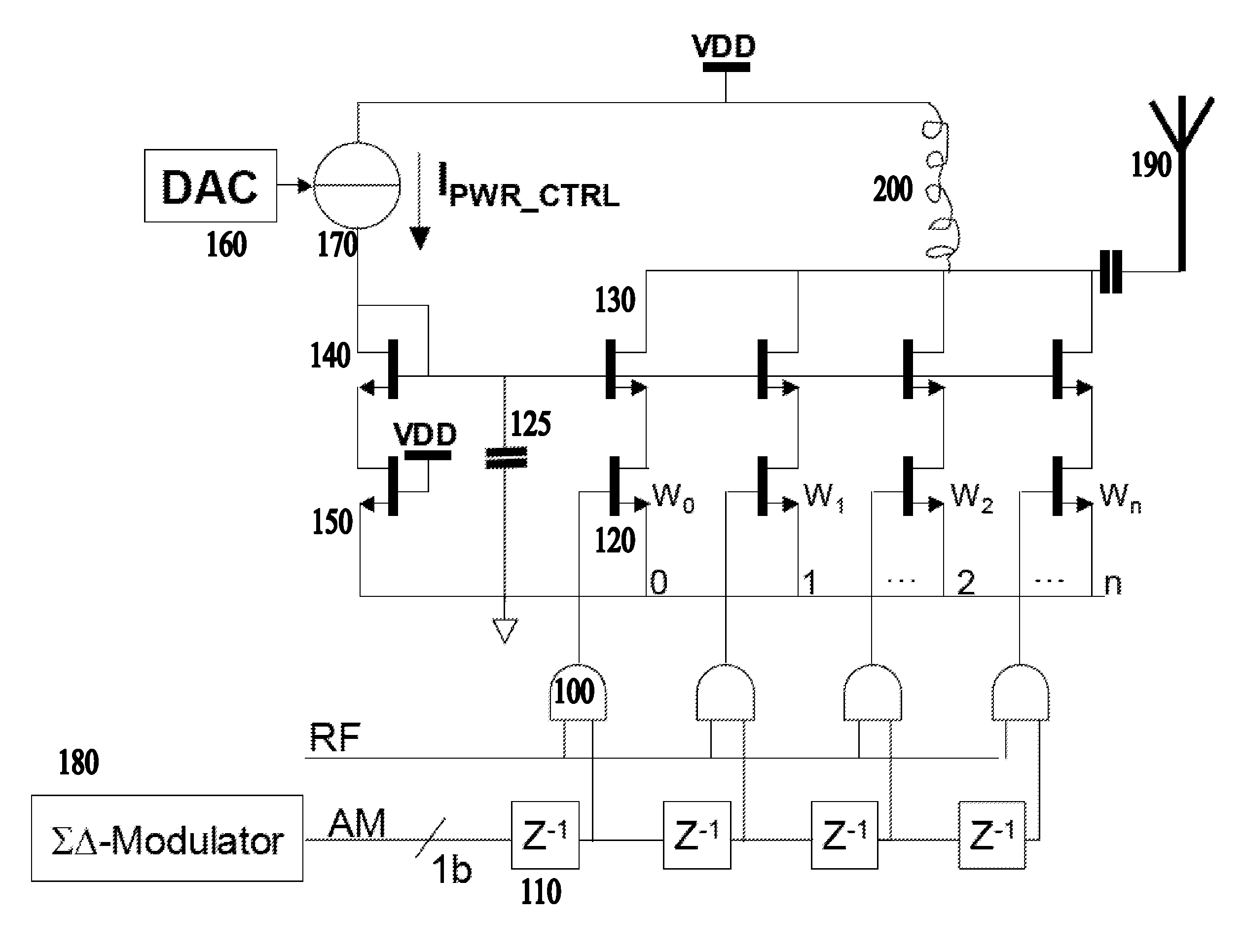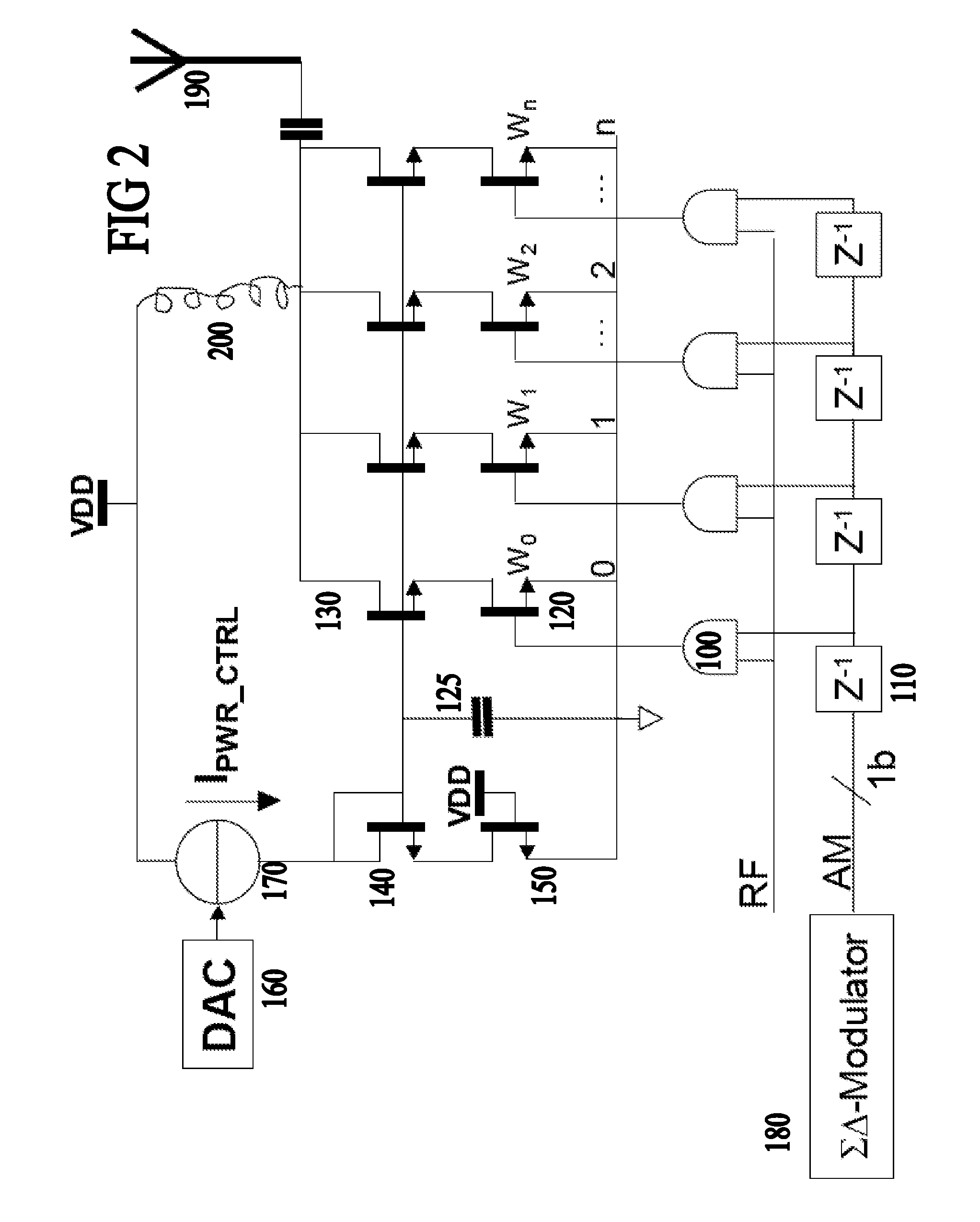RF Amplifier with Digital Filter for Polar Transmitter
a technology of polar transmitter and digital filter, applied in the direction of digital transmission, amplifier combination, gated amplifier, etc., can solve the problems of inacceptable spectral power emission, limited conventional power supply modulation techniques for many wideband applications, and several challenges for polar transmitters
- Summary
- Abstract
- Description
- Claims
- Application Information
AI Technical Summary
Benefits of technology
Problems solved by technology
Method used
Image
Examples
first embodiment
FIG. 1, a First Embodiment
[0041]In the embodiment of FIG. 1, an RF power amplifier 10 is shown having a converter 60 and a digital finite impulse response FIR filter 20. The converter converts the amplitude component signal into a 1-bit digital amplitude signal, which is fed to the digital finite impulse response filter. The filter has a number of delay elements 50 which provide successively delayed versions of the amplitude signal to successive taps 30 of the filter. Three taps are shown, but there can be many more. Each tap has an RF amplification stage 40 arranged to amplify the delayed versions of the 1-bit digital amplitude signal, the amplifying being according to a respective tap coefficient. Each amplification stage also has an input of an RF carrier modulated by the phase component. The filter is arranged to combine the outputs of the taps to provide the amplified RF signal. This can be fed to an antenna, or waveguide, or any transmission medium. The modulation of the RF ca...
second embodiment
FIG. 2, a Second Embodiment
[0043]This figure shows an RF power amplifier having a digital FIR of N unit cells, the taps of a Nth-order FIR filter. Each unit cell consists of a delay element Z−1 110 (e.g. implemented with a flip-flop), a gate such as an AND gate 100, and an amplifying stage in the form of an RF switch NMOS transistor (bottom NMOS 120) and a Cascode NMOS (top NMOS 130). The drains of the Cascodes of the N unit cells are combined and connected to the antenna 190. The digital AM signal is converted to a 1-bit digital signal by a converter in the form of a Sigma Delta Modulator 180. The AND gates combine the AM bit-stream and the RF carrier. The RF switch transistors 120 have weights W0 . . . Wn, as per the required tap coefficients weights to constitute the desired filter response. The weighting is achieved by using different dimensions for the switch transistors of different taps. The diode connected NMOS 140 on the left and dummy RF transistor 150, provide a relativel...
third embodiment
FIG. 3, a Third Embodiment
[0045]In the embodiment of FIG. 3, some parts are similar to FIG. 2 and corresponding reference signs are used as appropriate. Each unit PA cell consists of a delay element, an AND gate, an RF switch transistor and a current mirror, doubling as the Cascode transistor. Unlike FIG. 2, all unit cells have the same dimensions W for the transistors. The weight of the FIR filter tap coefficient is no longer determined by the dimensions, but instead is determined by the DC current provided by individual current sources 165 into each unit mirror. In this embodiment since all RF transistors have the same dimensions, there is good matching of RF characteristics and easier design of the layout. The matching of the tap coefficients is determined by DC transistors (the current sources I0 . . . In, 165) can have a large size (since there are no RF constraints, only DC).
[0046]Power control is achieved by controlling a common reference current to alter the full scale curre...
PUM
 Login to View More
Login to View More Abstract
Description
Claims
Application Information
 Login to View More
Login to View More - R&D
- Intellectual Property
- Life Sciences
- Materials
- Tech Scout
- Unparalleled Data Quality
- Higher Quality Content
- 60% Fewer Hallucinations
Browse by: Latest US Patents, China's latest patents, Technical Efficacy Thesaurus, Application Domain, Technology Topic, Popular Technical Reports.
© 2025 PatSnap. All rights reserved.Legal|Privacy policy|Modern Slavery Act Transparency Statement|Sitemap|About US| Contact US: help@patsnap.com



